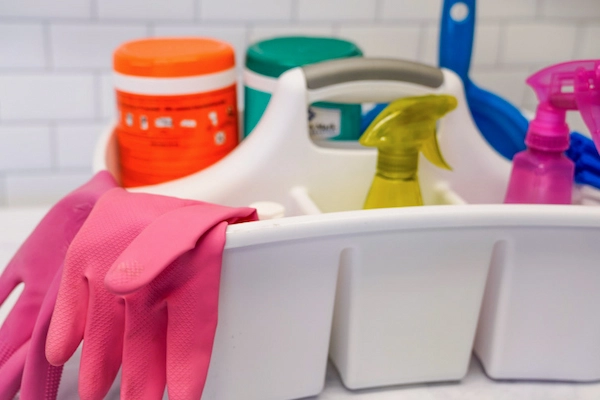
While most people clean their home on a regular basis, how many of us are actively disinfecting our homes? Every time someone goes in and out of the house, there is the possibility of bringing new germs into the home. By taking steps to disinfect high-traffic surfaces, we’re able to slow the spread of those germs and hopefully keep our families from getting sick.
Effective Disinfectants
The first thing to consider is what product should be used to disinfect your home. There are a variety of disinfecting products available for purchase and the CDC recommends using EPA-registered household disinfectants. The following disinfectants are used most commonly:
- Household Disinfectant Sprays: A variety of commercial disinfectant sprays are available and can be used to disinfect most solid surfaces.
- Disinfecting Wipes: Many types of disinfecting wipes are also available. They’re useful for keeping the disinfectant exactly where you want it.
- Bleach Solution: Combine ⅓ cup bleach per gallon of water to create a disinfecting solution. Spray or wipe the solution on the surface to disinfect and let sit for at least one minute.
- Alcohol: The solution should be at least 70% alcohol. Alcohol pads are great for quickly disinfecting small items like your phone.
How to Disinfect
Every disinfecting product works a little differently, so it’s important to thoroughly read and follow the directions on the product you’re using to disinfect your home. Many products recommend leaving surfaces wet with the disinfectant for a specific period of time to ensure it works thoroughly. Be sure to follow these guidelines precisely.
When disinfecting the home, consider frequently touched surfaces first, as they are the most likely to be harboring germs. These surfaces include doorknobs, faucets, tables, countertops, light switches, handles, desks, phones, keyboards, remotes, toilets and sinks.
Focus on the Kitchen and Bathrooms
Aside from frequently touched surfaces, the kitchen and bathrooms are the most likely places for germs to be hiding out.
In the kitchen, be sure to disinfect the counters every time you cook meat and keep your sponges clean to avoid spreading germs while you’re cleaning up.
In the bathroom, pay special attention to the toilet and sink when disinfecting.
How Often to Disinfect
Ultimately, the frequency of disinfecting is up to you, but there are some general guidelines if you’re really trying to keep illnesses at bay. When the flu, common cold or other sicknesses are making the rounds in your community, disinfect commonly touched areas in the home daily to protect your family. At times when you’re less worried about illnesses, two to three times a week should be plenty.
What to Do When You Return Home
One of the best ways to keep germs out of your home is to take some steps when you first return home after being out in the world. First, leave your shoes at the door. They can bring all sorts of grime into the house. Second, wash your hands for a full 20 seconds with soap and hot water each time you enter the house.
More Disinfecting Tips from Molly Maid
Consider these additional resources, each with tips for disinfecting specific areas and items in your home:
We spend a significant portion of our days interacting with computers. Learn how to disinfect these pieces of technology safely.
Don’t skip these six things when it comes to disinfecting your home.
Many items in the kitchen harbor germs left behind by cooking, like cleaning brushes. Learn to keep them clean.
Keep unwanted germs out of your mouth by disinfecting your toothbrush on a regular basis. It’s quick and easy!
Hand sanitizer may not be a replacement for washing your hands with soap and water, but it’s helpful to have on hand when you can’t access a sink.
Molly Maid Can Help Keep Your Home Clean
Need some help keeping your home clean? The professionals at Molly Maid are here to help with flexible cleaning services. Contact Molly Maid today!
